62: French regional patterns: the queens and jacks
Continuing our look at the figures from the regional patterns of France.
The queens and jacks of the French regional patterns can also be found used in the different portraits, though there seem to be fewer of them compared to the kings.
The Queens
Some of the queen figures seem to be used with some variation in different court sets. It is difficult to know whether some of the figures should be considered sub-types or constitute a separate type. We can see this problem in dealing with Q1.
Q1 seems to have two slightly different types: one from the Perrocet set, who holds her skirt up and the other from Lyons 2 (the IV pack), who doesn’t. The latter appears in later packs, too. Notice, too, that her belt may be straight or twisted.
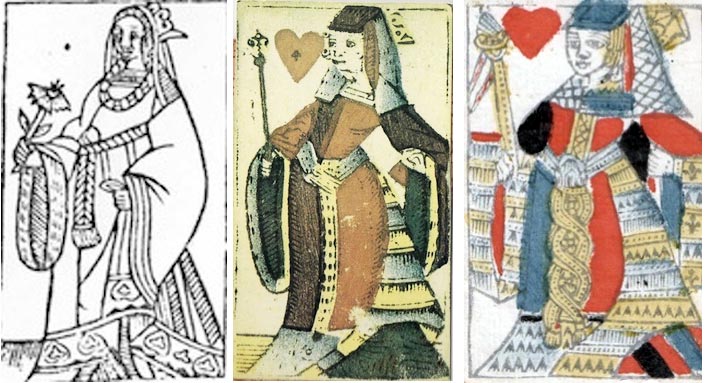
Above: Perrocet QD; IV QH; early 18th century QH, possibly from Burgundy
She appears in both Paris patterns (Paris 1 & 2) and Burgundy as QH and in Languedoc as QS.
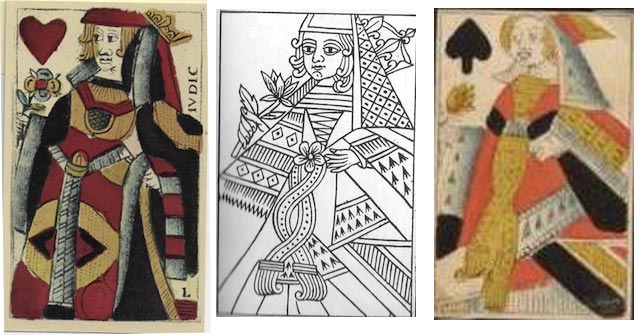
The QH in Provence is another possible candidate for Q1. In early packs she appears as a hairy 'wild woman’, but this feature disappears in the later 18th century. She faces right, as does the Rouen 2/English QC, who is another candidate for the group.
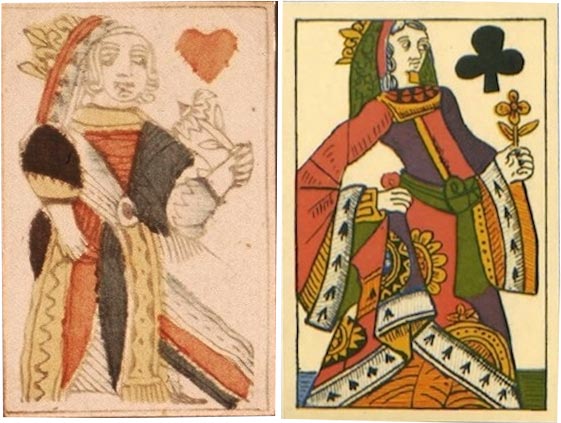 Above: Provence QH/Rouen QC
Above: Provence QH/Rouen QC
There are several other possible members of this group who hold both a sceptre and a flower; I discuss these in my TPC article. They may constitute a separate group.
Q2 is found in Perrocet’s set and in later Lyons 1 packs. She holds a glove in her right hand. She may be the model for the Lyons 2 QC facing left and the QD facing right, who seem very similar to one another, but who hold flowers and fans.
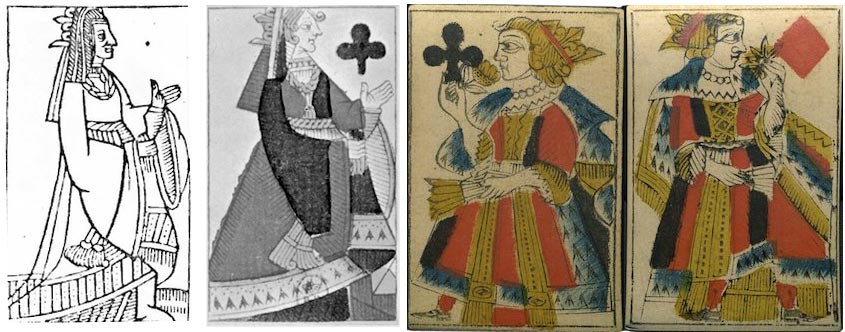
Q3 is another figure who seems to come in two versions: the Lyons 2 QD with a short ermine jacket and the Paris QS with a long panel at the back of her dress. One version appears in Languedoc as the QH, and both versions seem to be used in Provence as the black queens, sometimes facing in opposite directions, sometimes both to the left.

Q4 is found in Lyonnais packs, in Perrocet and Lyons 1 as the QH and in Lyons 2 as the QS; she is also the QC in Paris 1.
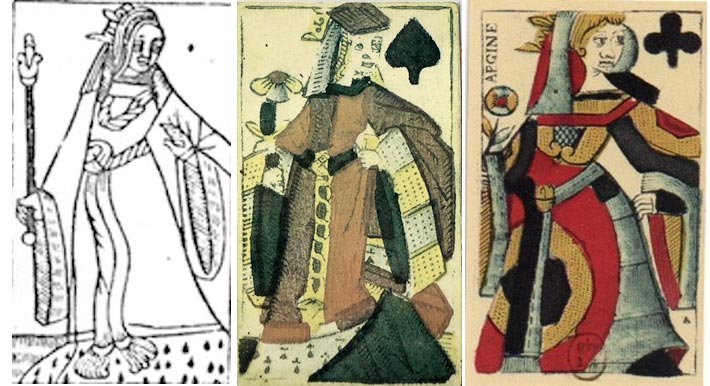
Q6 has voluminous ermine sleeves: she’s QC in Lyons 2 and QD in Burgundy and Provence, though in the latter case she faces right.
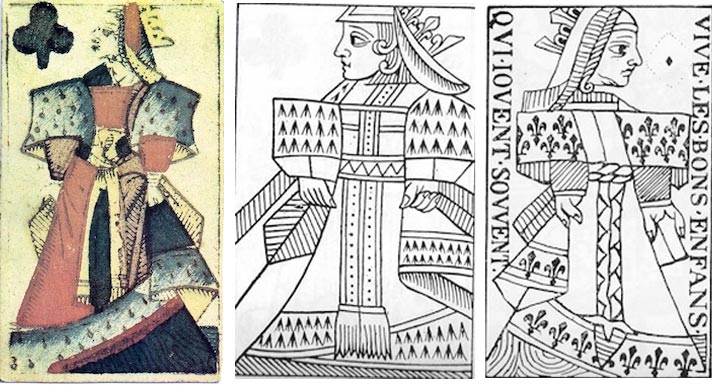
The Jacks
J1 is widespread. He has one hand on his hip and the other resting on his halberd. He is the swaggering JC in Perrocet’s sheet and the JH in Provence and Burgundy. He is the JC in Lyons 3. In these examples it is possible to see how the vitality of the figure has been removed by continued copying. The swagger of Perrocet’s jack with his hips and feet at an angle, which gives some element of three-dimensionality, has been flattened into a straightened two-dimensional design. In Lyons 3 the angled arm has even been reinterpreted as a shield. All this alteration has its parallels in the changes of the Rouen 2 pattern in its development into the standard English pattern: just think of the equally swaggering Maréchal JC and its 18th and 19th century equivalents.
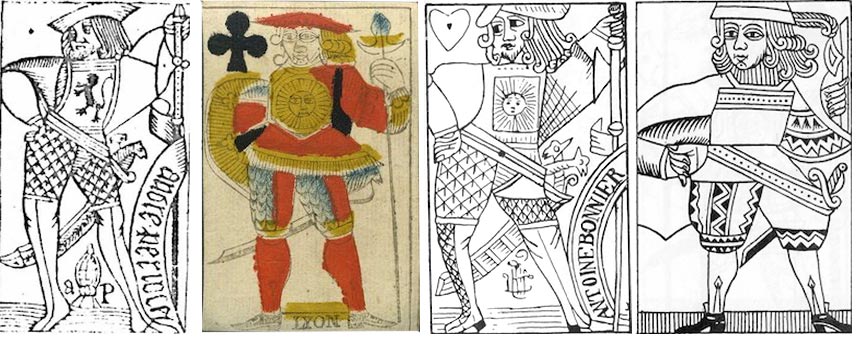
He also appears as the JS in Languedoc and the JC in Dauphiné facing right.
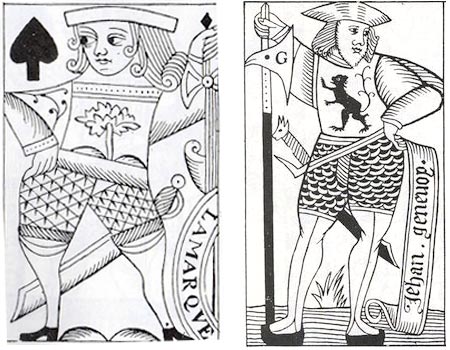
J2 is restricted to Lyons patterns as JS: Perrocet, Lyons 1 and Lyons 3. In the last version he has his front to us rather than his back. This change of orientation happens very easily when indistinct hands are interpreted as facing forward rather than away from us, so the back of the body, then becomes the front. Sometimes the hands are turned but the figure isn’t; we find the same situation with several standard English cards, e.g. JH and JS.
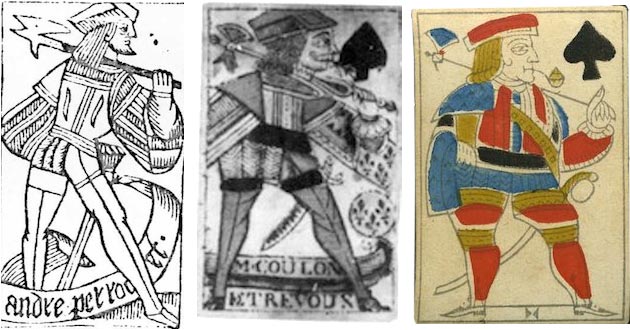
J3 is the profile jack who turns up as the English JS. He is JH in Lyons 1 and Languedoc and JD in Paris 1. The English JS lost the hand behind his back early on.
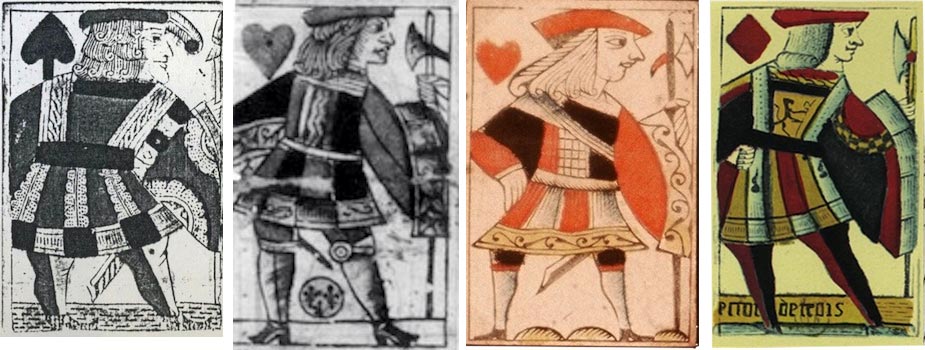
J4 is the JC in Lyons 2, JS in Provence and Burgundy and JC in Languedoc facing right.
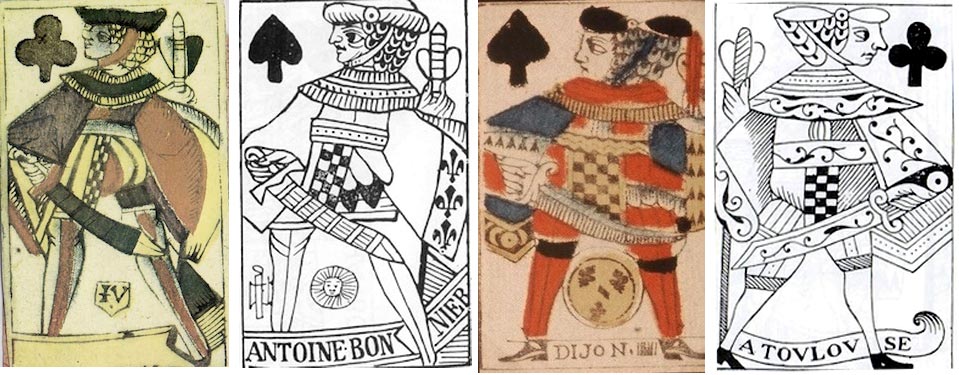
He has curly hair and a strange cap with a chin strap; in later packs the cap looks like two propeller blades! A very similar figure appears as the JC in Provence, but with a raised hand and no sword. In turn this figure is reminiscent of the English JH, though he holds a staff and does have a sword.
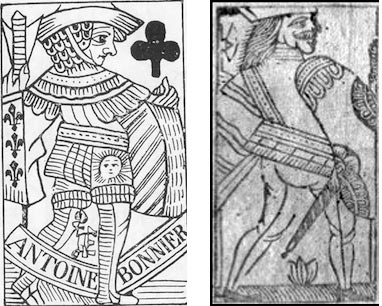
J6 is JD in Burgundy and Guienne. Guienne and Languedoc are usually considered to be more or less the same, but in the case of the JD, the former has a beard, the latter doesn’t. (There’s a dirty smudge on the image below, but no beard!)
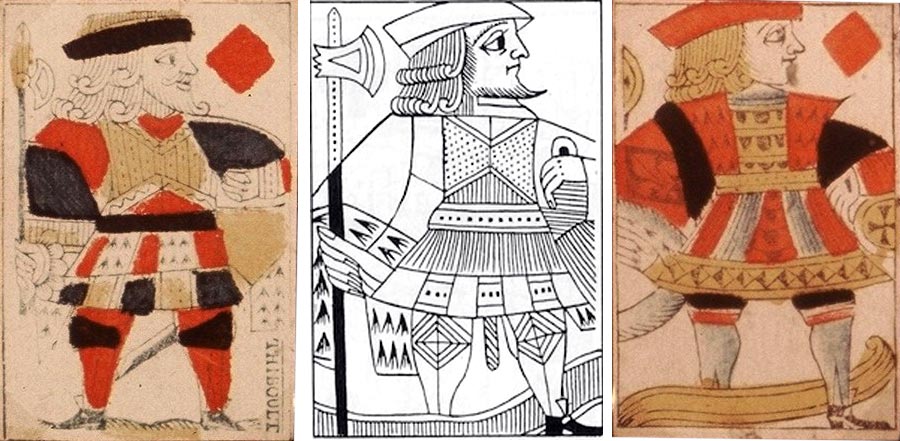
This brings me to another problem. The are a number of figures that are very similar and sometimes from the same pattern. If we consider the jacks from Auvergne, they all wear helmets, their heads are in profile and they all wear beards. The JD is like J6, but are the others to be considered variants of the same figure? It’s not an easy question to answer.
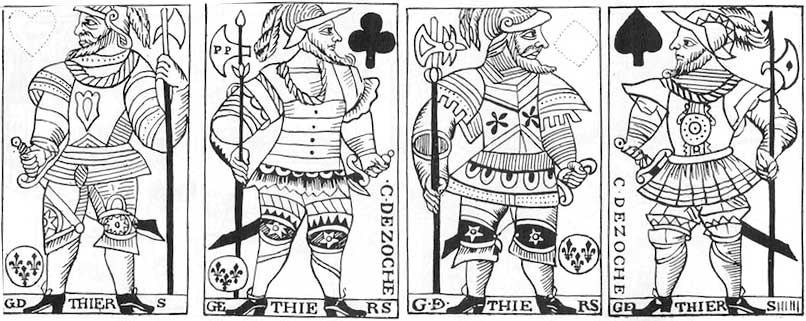
J7 is restricted to Paris, but has some early forebears.
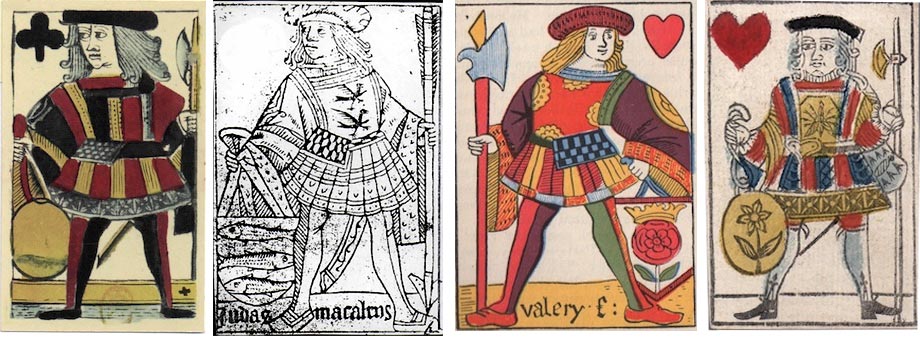 Above: JC Paris 1; Jack from the Guymier sheet; JH by Faucil; a Paris 2 JC masquerading as the JH! Probably a stencilling error.
Above: JC Paris 1; Jack from the Guymier sheet; JH by Faucil; a Paris 2 JC masquerading as the JH! Probably a stencilling error.
In the early court sets the figures hadn’t settled into the suits we know from later packs. An interesting example is provided by Faucil, who worked in Rouen in the 1540s. Here we have the axe-wielding king as the KC (bottom missing), the QD is the later (English) QC and the red jacks are not found in the later Rouen 2 packs. The (part) JC is J1. This assumes these odd courts are all by Faucil and the same kind of pack.
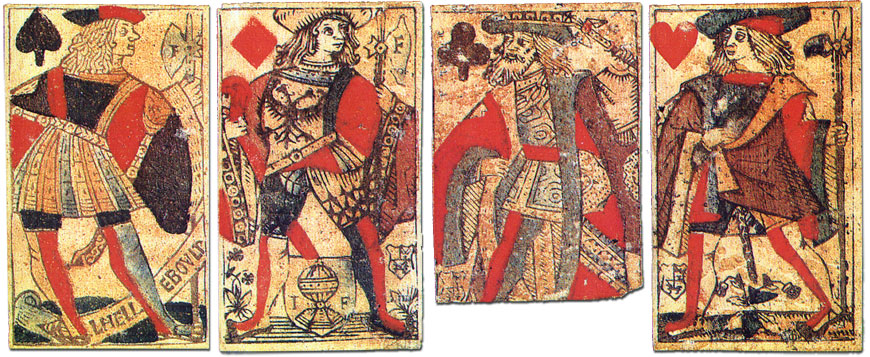
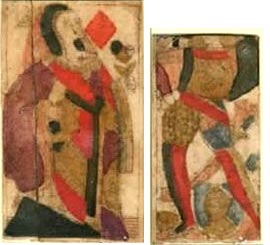
The Faucil JH turns up as the Paris 1 JH facing the other way, but he disappears when Paris 2 is introduced.
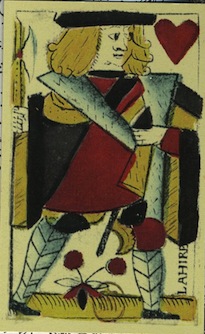
There are other figures which may or may not be related to the ones I’ve discussed here, but it’s certainly fun trying to work out the relationships between the many court cards of France.

On the next page I'll look at some of the descendants of these regional patterns.
By Ken Lodge
United Kingdom • Member since May 14, 2012 • Contact
I'm Ken Lodge and have been collecting playing cards since I was about eighteen months old (1945). I am also a trained academic, so I can observe and analyze reasonably well. I've applied these analytical techniques over a long period of time to the study of playing cards and have managed to assemble a large amount of information about them, especially those of the standard English pattern. About Ken Lodge →

Related Articles

78: The Standard English pattern - Part 2, the tricky bits
There are many less straightforward aspects to the designs of the English pattern, which need carefu...

Burgundy pattern - portrait bourguignon
The old Burgundy (or Burgundian) pattern by Nicolas Chenevet, Dijon.

Lyon pattern by Michel Ressy
Lyon pattern by Michel Ressy, c.1760.
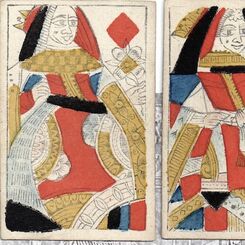
73: Fakes, forgeries and Tax Evasion
When there are oficial taxes to pay, people will find a way to avoid paying them - often illegally. ...
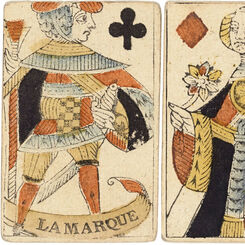
Languedoc pattern - Portrait de Languedoc
The old Languedoc pattern was known at the beginning of the seventeenth century, if not before.
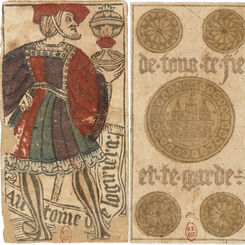
Antoine de Logiriera
Archaic Spanish-suited playing cards published in Toulouse by Antoine de Logiriera (1495-1518).
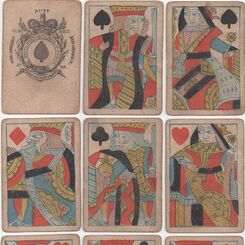
71: Woodblock and stencil: the hearts
A presentation of the main characteristics of the wood-block courts of the heart suit.
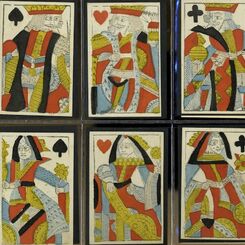
70: Woodblock and stencil : the spade courts
This is a presentation in a more straight forward fashion of the work done by Paul Bostock and me in...
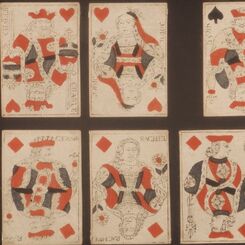
64: The descendants of the French regional patterns: 2
A continuation oF the development of the off-spring of the Paris patterns and a few examples of how ...
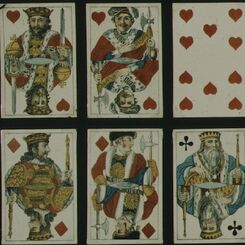
63: The descendants of the French regional patterns: 1
A great many regional patterns were exported from France and subsequently copied elsewhere. Some of ...
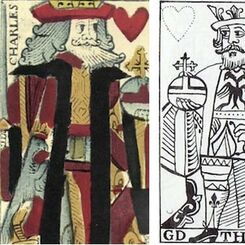
61: French regional patterns: the kings
On page 11 I illustrated several examples of the regional French patterns from Sylvia Mann's collect...
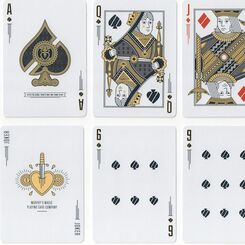
51: Some modern variations
A brief survey of some current variations in the standard English pattern.

49: De La Rue in detail
A detailed presentation of the variants of De La Rue's standard cards.
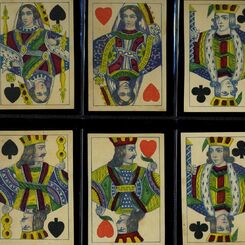
21: Belgian Makers: Brepols and Biermans
Brepols started making playing cards in 1826, although he had been in the printing trade since 1800....
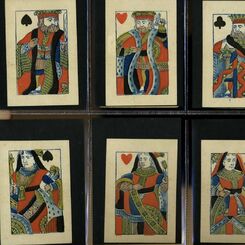
19: 19th Century Breaks with Tradition - Unusual versions of the Standard English Pattern
The centuries-long tradition of English court cards was subject to misinterpretation and in some cas...
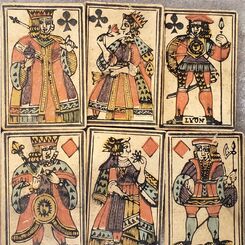
Lyon Pattern type iii
This pattern was used in various parts of eastern France but was ultimately replaced by the official...
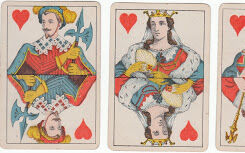
6: Some Non-Standard Cards
I only collect the English standard, but I thought it would be a good idea to add some different typ...
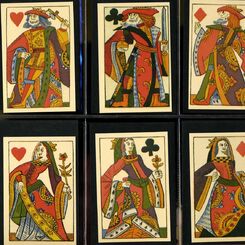
1: Playing Cards and their History: An Introduction and some links to other sites
What was considered the first mention of playing cards in England is in 1463 when Edward I banned th...

History of Court Cards
The court cards in English packs of playing cards derive from models produced by Pierre Marechal in ...
Most Popular
Our top articles from the past 60 days























